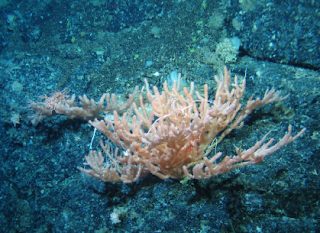The words ‘coral reef’ conjure up mental images of tropical sandy beaches, cocktails and colourful fish. For me however they conjure up images of long oceanic voyages (sea sickness tablets), large pieces of deep-sea sampling equipment and all manner of colourful animals (Nemo doesn’t have a patch on these guys…). You see, corals are not confined to the shallow warm sections of this planet; they in fact occur in every Ocean, even the very coldest, and have been found thousands of metres down where the water is anything but tropical. Deep-sea corals exist by filter feeding from the water around them. As such, they need to be in areas of strong currents. They also need a solid base to grow on making seamounts ideal locations.
There are just a handful of hard skeleton deep-sea coral species that grow into large reef frameworks. When this does happen these reefs are a sight to behold; even the small areas seen so far on this expedition have been home to a bewildering array of animals. We have seen baby-pink lobsters (whose abodes are immediately filled by another once one is sampled), the tiniest yellow sea spiders, intense-red anemones, flame orange fish and electric purple octocorals (who are unusually always home to the same big snake-armed brittlestar species).
In general, the deep sea of the Indian Ocean is very understudied, certainly one of the least studied regions for deep-sea corals globally, making discoveries to be made on this expedition very important and very interesting indeed.
 |
| ROV images; Coral seamount; Isididae sp. - unknown, next to some bottlebrush octocoral |
 |
| ROV images; Coral seamount; Isididae sp. - unknown bamboo coral with Galatheid crab and brittlestars |
